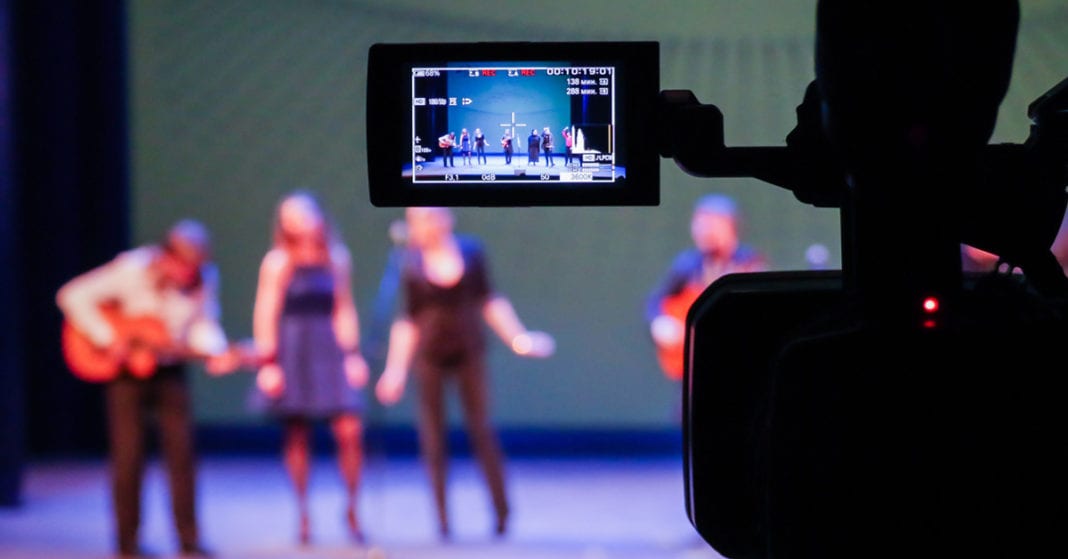There are a few different methods for synchronizing an audio playback computer (running Ableton Live, Protools, etc.) and a video playback server (with ProVideoPlayer, Resolume, etc.). One of these avenues is via SMPTE Timecode. If you’ve never heard of this protocol, I’ll spare you the technical jargon and summarize that this method allows you to use a single, generated audio file to trigger audio and video devices simultaneously (and lighting, too! …but I’ll omit that for now).
Below is a quick 10-step tutorial on how you might use this technology for an individual song in your worship set.
1. Grab the audio file (i.e. an iTunes file) for the song you’re programming to. Import that file into your DAW of choice (Logic, ProTools, etc.). Place the song onto the correct tempo grid and slide it to so that there is exactly 1-bar of click track before the first downbeat. Make any additional edits to the song form, to reflect how the song will be performed live. After you’ve done all that, export the new arrangement (with the 1-bar margin on the front)
2. Decide on a starting SMPTE timecode for the song. SMPTE timecode is read as Hours : Minutes : Seconds ; Frames. It’s recommended that you select clean 10-minute intervals such as 01:20:00;00 or 09:40:00;00
(Note: avoid going above Hour 23, as some programs/machines cannot read beyond that point)
3. Decide on a frame rate for the video. This is a critical component! If you’re not sure which frame rate to go with, you might opt for 30fps, as a lot of programs and processors will default to this setting. (Although 24fps is a traditional U.S. film rate, this may be one instance where it could be problematic). Whichever frame rate you decide, all devices need to program to this frame rate.
4. Take all the assets and information from Steps 1-3 and deliver them to your Video personnel. They need to edit their composition to these specs: the new audio file with 1-bar at the top, the starting timecode, and the frame rate.
(Note: some video editors may have never exported a video with a specific starting timecode, but it’s easy to do in any editing program)
5. Once all the assets are completed, an SMPTE Timecode audio file can be quickly generated. A lot of the DAWs have an SMPTE generator within the program, but if that’s too difficult to navigate, then simply go to ElTeeSee.pehrhovey.net and generate one for free. You’ll want to create a file that has the frame rate you’ve decided upon, the audio sample rate and bit rate that matches your other audio stems/tracks (44.1khz 16-bit is very common), the starting timecode you’ve selected, and a length that is longer than your song (i.e. for a 6-minute song, generate a 7-minute file). Generate!
(Note: the audio codec doesn’t matter very much. WAV, AIFF, or mp3 are all suitable)
6. Begin loading audio files to your audio playback computer (running Ableton Live, Protools, etc.). Drop in all your regular stems/tracks. Also, drop in the SMPTE file for that song. Careful! Do not hit play! The sound of an SMPTE audio file is painful. You will need to route the audio channel/track for the SMPTE file to a separate, designated output on your audio interface. (i.e. if you have an 8-channel audio interface, route it to Output 8. Make sure that output is being used ONLY for SMPTE). Within your audio playback app/program, ensure that the SMPTE file is positioned to fall exactly 1-bar before the first downbeat. So, if your song has a 1-bar count-in, the SMPTE file will begin on measure 1. If your song has a 2-bar count-in, then your SMPTE file will begin on measure 2.
7. However your PA system is setup, you will need to route the analog audio signal from the designated output of the audio interface to the Video playback machine. For example, for most video servers, you can just plug the audio line right into the computer’s built-in microphone port.
8. Instruct your video software how to “listen” for SMPTE. For example, in ProVideoPlayer, go to Preferences and click on the Audio tab to select the device (like Built-In Microphone).
9. Begin loading video files. In whichever playback software you’re using, you’ll need to assign the starting timecode to the video. For example, in PVP2 and PVP3, there is a special Timecode Playlist function that will allow you to do this by clicking and typing.
10. Once everything is loaded and all the devices are connected via the analog audio signal, hit play on the audio playback computer. Now everything should be running in sync!
A few common troubleshooting points:
- If the video is lagging behind the audio, that means there is latency somewhere in the system. Some common sources of latency are: the video playback computer needs time to buffer, an LED processor needs time to buffer, etc. This does not mean your equipment is bad; it just means that the latency needs to be compensated for at some point in the overall signal flow.
- If the video is “jumpy” or skipping frames, that probably means that someone forgot to use the correct frame rate, or that your video playback software does not like the frame rate you chose.
- Certain devices and programs prefer to receive SMPTE at a certain volume. So you may need to adjust the output volume of that channel/track on your audio playback computer.
If you’re wondering, “where can I learn more about improving my musical and artistic community within my church?” be sure to check out LIFT Conference at Passion City Church.












